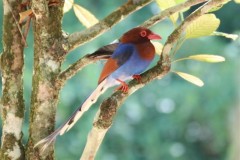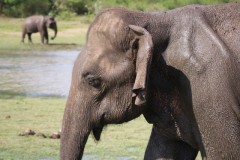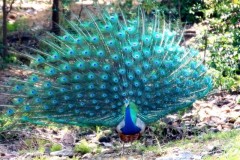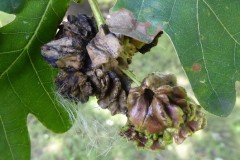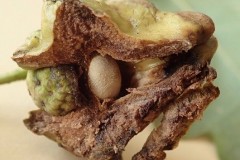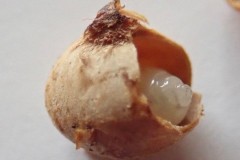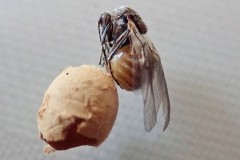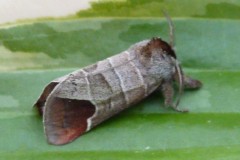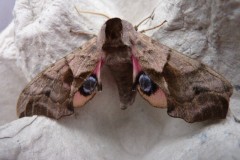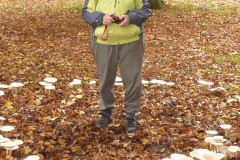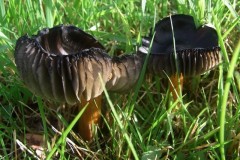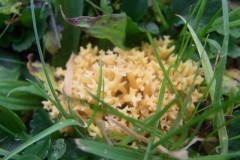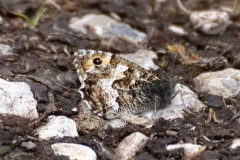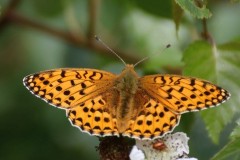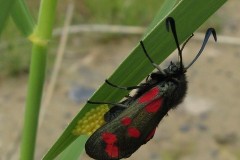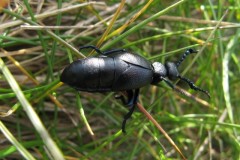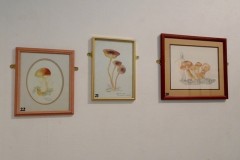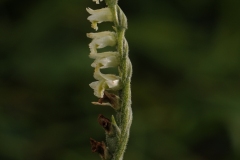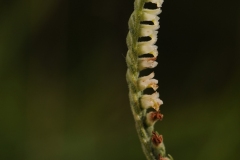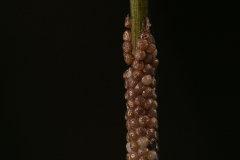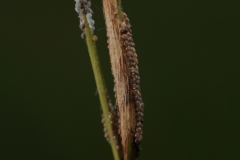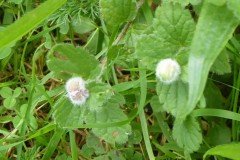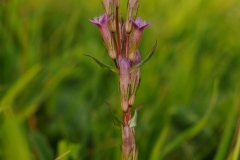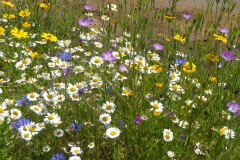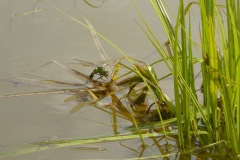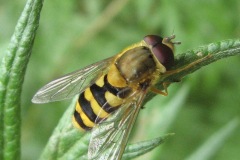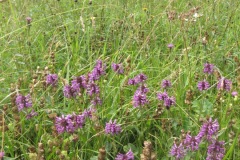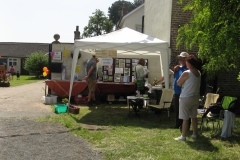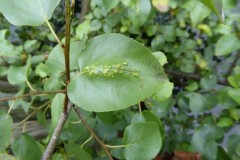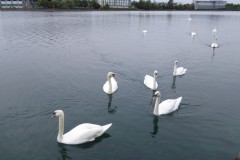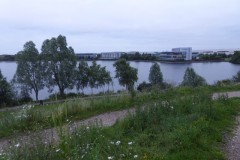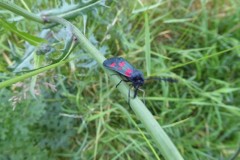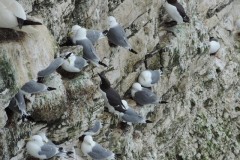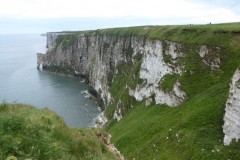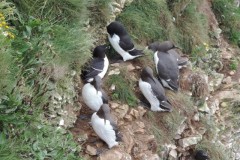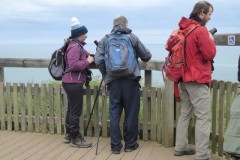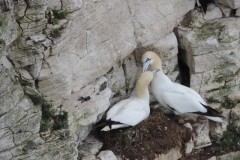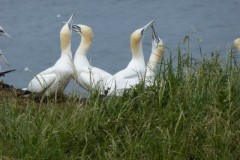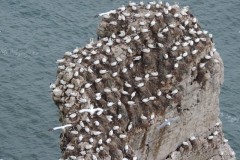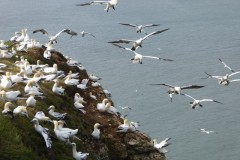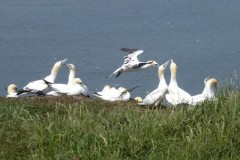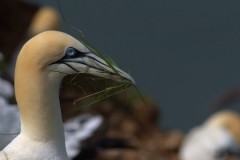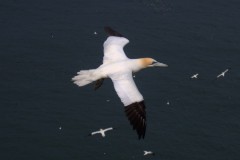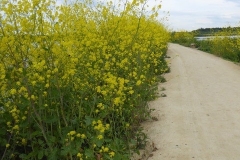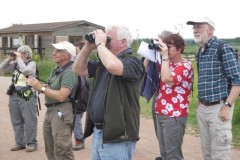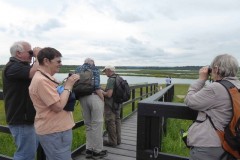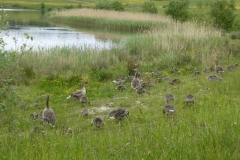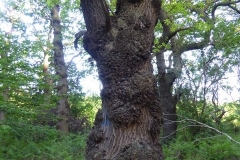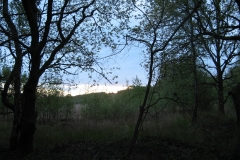Sri Lanka Wild and Beautiful
Wednesday 4 December 2019
Paul and I did a double act, talking about our wildlife watching trip to Sri Lanka run by a Leeds bird watching company, Bird Holidays. We loved the country – wild and beautiful, and the people – friendly and interesting, very much enriched by an excellent and very knowledgeable Sri Lankan guide.
The cultural highlights included visits to Buddhist temples, such as the Temple of the Tooth in Kandy and a visit to a tea estate in the mountains. Our trip included Blue Whale encounters off the southern port of Marissa; visits to National Parks to see Indian Elephants, deer, big and small lizards, fat and very thin snakes, butterflies and dragonflies, to mention a few.
The highlights were probably the birds. As they are not persecuted, we had close encounters and managed close-up pictures of some very colourful and beautiful birds, with a finale of a male peacock with its tail erect.
Joyce Simmons
Activities outside of the arranged meetings
The meeting started with a rather heated discussion about the recent flooding in Doncaster and the responses made by the Environmental agency and Doncaster Council. It was obvious people had very strong views about the series of events which led to the flooding of several areas around the River Don and what’s likely to happen in the future. We returned to this topic later in the evening when Louise Hill showed us some of her photographs and footage of some of the flooded areas.
The first topic of the evening was my investigation into the development of the cynipid gall wasp Andricus quercuscalicis through opening the inner galls of several knopper galls, the asexual generation. The photographs I showed to the group illustrated the stages which I observed over a period of two months starting with a larva on the 2nd of September and ending with a fully mature wasp removed from a gall opened in late October.
Most of the photographs were taken with an Olympus Tough T5, a pretty impressive compact camera which gave me some fairly good close up photographs of the wasp which was only about 5mm long. The photographs below show mature knopper galls on Quercus robur, a knopper gall cut down the middle revealing the inner and outer gall, an inner gall containing a larva and finally a mature wasp next to the inner gall in which it developed
Next, Margaret Prior focused on two topics; Moths in her garden and Fungi at Clumber Park. Margaret has been recording moths found in her traps at home for a long time and in a portable trap which she takes on holiday. The first few slides illustrate some of the moths which were new to her garden. The photographs below from left to right are Chocolate Tip and Eyed Hawkmoth.
She then showed several fungi taken on a recent visit to Clumber Park where the main highlight of the visit, apart from the huge number of fungi in general, was the amazing circles of Trooping Funnel in between the lime trees down Lime Tree Avenue. (as seen in the photograph below).
Tricia Haigh was next and she focused her collection of photographs on the species of fungi found and identified by local mycologist Kevin Gilfedder in both the old and new parts of Finningley churchyard and amazingly over 50 different species were found, including a number of wax caps which is indicative of ancient grassland.
Then followed Paul and Joyce Simmons who did a joint presentation showing us some of the highlights of their quest to find butterflies in various parts of the country, including Arnside Knott and Gait Barrows in Cumberland. Below, on the left, you can see a photograph of Grayling and on the right, one of Dark Green Fritillary, both taken at Arnside Knott.
Louise then showed us amazing footage of the results of flooding in the Don area and some photographs taken on visits which weren’t with the Nats. The first on the left, taken in June at Bentley Pit Top, is a six burnet moth laying eggs and the one on the right is an oil beetle taken on the cliff tops at Flamborough.
It was another very enjoyable evening at Parklands.
Nora Boyle
Little House of Horrors by Colin Howes M.B.E
Our speaker for this meeting was Colin Howes M.B.E. who worked at Doncaster Museum from 1969-2008. His first position was as Assistant Keeper of Natural History for South Yorkshire County Council and later, in 1986, he became Environmental Records Officer in the Planning Department looking at the Natural History implications of incoming applications.
Colin gave us an excellent powerpoint presentation of records collated from enquiries by the general public who contacted Doncaster museum with photographs or actual specimens they had found or couldn’t identify. Using information from as far back as 1977, he used pie charts, histograms, graphs, photographs and anecdotes to illustrate his talk about such things as the incidence of Elephant Hawk Moth caterpillars, Woodwasps and the Garden Centre Spider, amongst others.
This talk was giving us a flavour of what it was like in the past where the museum was an important contact for Natural History observations made in Doncaster both for identification purposes and ultimately records. When the Natural History staff was at its full complement there was a range of expertise from Geology to Botany to Archaeology etc. Martin Limbert, Peter Skidmore and Colin each answered enquiries from all over. Most from South Yorkshire but some from as far afield as the Yorkshire Dales and East Yorkshire. People contacted Doncaster Museum in preference to other institutions because it had such a good reputation but the management saw this negatively because it took Colin and his colleagues from what they were being paid to do. The number of enquiries rocketed when e mails became more popular so between 2000 and 2008 Colin handled over 14000. Interestingly he said that the total number of records produced by Doncaster Museum was greater than the other museums in Yorkshire put together.
He pointed out that all the information he told us about is published in folders in his old office in the museum so when the allocation of rooms is complete it is hoped that they will be available to anyone wishing to carry out research into past records.
At the moment there is no one person in employment at the museum carrying out a similar job. However should anyone contact the museum with such enquiries the arrangement is they will be directed to Louise Hill, Pip Seccombe or Colin Howes.
After Colin’s presentation we held a long awaited discussion about the future of Dorothy Bramley’s paintings which at the moment are being held in the Natural History room at the museum. We discussed both the suggestion that we might use them as a library where members could loan the pictures for a given period of time then return them to a central point and the possibility of selling them, giving the membership first opportunity to purchase. There were considerations for both suggestions.
The day after, on Thursday 7th November, Louise and I met with Anne Marie Knowles, who is the Operations manager for Heritage Doncaster, to discuss the future of Colin’s old room and Dorothy’s paintings and books. Anne Marie is now aware of the contents of the room and assured us that should the room be allocated a different purpose we would be informed and so at the moment there is no urgency to find a new home for Dorothy’s paintings. She suggested that a couple of them might be used in an exhibition of work by local artists. We are still open to suggestions as to how we can best use them. So please let the committee know if you have any suggestions to look into.
We started the indoor meetings at Parklands with an extremely interesting talk by Francis Hickenbottom entitled “The Peregrines of Wakefield”. These Peregrines have been nesting 40 metres above ground in a nest box in the spire of the Cathedral. A live camera has been watching their progress from being youngsters in the nest, to being ringed at three and a half weeks old to leaving the nest and the fledglings passing food to each other whilst in the air. In five years the adults have had 17 chicks and adopted one chick. Surprisingly, every egg that hatched survived to the fledging stage. If you want to see the male bringing a dead bird to the fledglings visit “Wakefield Peregrines” on You Tube where you can also see a live cam.
After a brief break, the second half of the talk comprised a series of short videos taken with a Trail Cam situated by the side of the river near to Ackworth school featuring amongst others otters, foxes, roe deer and hedgehogs.
Both talks were very much appreciated by the membership and we thanked Francis for his inspiring presentation.
Nora
Seven botanists turned up to this Magnesium limestone grassland site hoping to find Autumn Lady’s Tresses Spiranthes spiralis in response to a request by Ivan, a YNU member. This plant differs from all other white -flowered orchids except Creeping and Irish Lady’s Tresses in its flowers being arranged spirally up the stem. Louise remembered that on a previous occasion we had found specimens on one of the mounds and after a short search we found eight specimens. The plants were quite small and difficult to photograph with a compact camera but Les Coe had brought his SLR with a macro lens and took some very nice images as you can see.
Amongst other species typical of magnesium limestone grassland we found Clustered Bellflower – Campanula glomerata, Hoary Plantain – Plantago media, the white, tiny- flowered Squinancywort – Asperula cynanchica and Small scabious – Scabiosa columbaria. We also found a lot of Sneezewort – Achillea ptarmica, Autumn Gentian –Gentianella amerella and Tor grass – Brachypodium rupestre. After finding a lot of fairly short specimens of Tor grass I came across what I thought was a more typical specimen taller with a more elongated stem between the spikelets and handed it to Louise for confirmation that it was indeed Tor grass.
Whilst looking for the short awns with her handlens, Louise discovered that much of the flower was covered in eggs as you can see in Les Coe’s fantastic photograph.
As usual I was on the lookout for galls and was pleased to find specimens of Germander speedwell galled by the midge Jaapiella veronica. The midge attacks the shoot tips causing the two terminal pairs of leaves to cling together and form a hairy pouch. Each pouch contains numerous orange larvae.
After a couple of hours the weather started to change and feeling that rain was imminent, we drew the meeting to a close.
Six members met up in the car park next to Hollicars Holiday Park at Escrick. As we walked into the meadow we came across a few volunteers demonstrating the art of Scything. Several other activities had been scheduled for that day. We then met up with Rosalind Forbes whose family owns the land and she explained that the meadow was seeded in May 2013 with the help of a Woodland Grant scheme. She explained the thoughts behind the planting and plans for the future and expressed a desire to hear any thoughts from Doncaster Naturalists about what they had already established.
The area referred to as Three Hagges Wood consisted of the meadow bordered by scrub and beyond the scrub trees planted to establish a high canopy. The meadow had recently been cut so walking was easy. At the far end of the meadow area was a pond which was only just getting established. We had lunch and then walked back to the car park with the intention of taking a look at the second of the two ponds on the site. It was fringed on one side with a colourful wild flower mix. Here we saw several dragonflies including an Emperor laying its eggs in the water.
Finally we were shown some plants which were being grown in poly tunnels to be planted on the site and Louise and John made suggestions as to the most appropriate places to plant them. Ros asked Louise to send her some comments on the woodmeadow concept.
Nora Boyle
Dear Ros,
Thanks very much for the guided tour!
You asked if we could provide a few comments on the woodmeadow concept.
I think everyone who attended thought that it was an excellent way of creating new woodland habitat. It has the advantage of creating a herb rich sward which will survive between the trees as they develop a full canopy over time. You have also established clearings and rides that are large enough to remain as open nectar- and pollen-rich areas even when the trees do grow taller and start to cast more shade. The other benefit of this approach is that you create a lot of ‘edge’ habitat. In my experience the transition from open grassland, through tall herbs and scrub, to high canopy woodland is probably the most physically-diverse and species-rich habitat. The inclusion of some open water areas is great because it adds even more variety to the range of habitats present. You might like to consider creating more small-scale variations in topography such as creating shallow scrapes (either waterlogged or just bare ground) and small banks and mounds of bare sand. Perhaps this is not suitable where you need the clearing to be mown by machine but it might work in areas where grazing is possible.
I hope these comments are helpful.
Regards,
Louise
Doncaster Naturalists’ Society
Attendees; Louise Hill, Tim Prosser, John Scott, Catherine Porter, Jim Burnett, Gill Johnson
We had a leisurely stroll along the Dearne – where we spotted two or three plants of the invasive alien species Giant Hogweed growing on the far bank before heading for the viewpoint in the middle of the Reserve. We then back-tracked to the main Bridleway and did a clockwise circuit of the perimeter. On our travels we found an odd looking goat’s-beard plant. John suspected it might be the less common subspecies Tragopogon pratensis subsp. pratensis but the ‘jury is still out’ on that one. We saw plenty of ladybirds (including Harlequins) and hoverflies, and also family parties of pied wagtails and lapwing feeding on the damp muddy grasslands.
Afterwards, a small group went on to look at Owston Meadows. The betony was in full flower. The meadow was cut the following week.
Louise
With thanks to all those Nats members who turned up and volunteered to man the stall.
We had a prime spot at the courtyard entrance and received plenty of interest in the stall and displays, but only had one attendee on the nature walk. Perhaps the weather was too warm.
Attendees: 6 members and 2 guests
Site Description: Lakeside island and the hill adjacent to Sandy Lane.
We met by the roundabout at the end of Lakeside Boulevarde and took a brief look by the shingle beach at the material Doncaster Council had arranged to be dredged from the lake. The evening sky was cloudy and so we decided to head straight for the island before the light levels dropped too much. On the way, and while we were on the island we looked out for plants, insects, galls and birds, paying particular attention to notable sightings such as a lone fig tree growing on the edge of the lake , a scale insect which was covering all the branches of a small tree and lady fern growing by the side of the wooden fence. There were several orchids in small numbers including Pyramidal, Bee Orchid and Common Spotted and quite a few Broad leaved Helleborine. On an Italian Alder leaf we found mite galls caused by Eriophyes laevis.
Several birds were raising their young, including coot and mallard. Little grebes were around but their chicks which were evident a couple of weeks ago weren’t to be seen.
Here is a list of the birds we recorded
| Blackbird | Black headed Gull | Blue Tit |
| Canada geese | Coot | Gadwall |
| Great Crested Grebe | House Martin | Kestrel |
| Little Grebe | Magpie | Mallard |
| Mute Swan | Oyster Catcher | Pied Wagtail |
| Reed Bunting | Swallow | Swift |
| Tufted Duck | Wood Pigeon |
As the light faded there was a better contrast between the water and mute swans affording quite a nice photo of the birds swimming towards us on the off chance that we might have some food.
The water round the perimeter of the island was devoid of life and had a distinct shade of blue, the council having added some kind of chemical , probably food grade colouring, to cut down light penetration and prevent blue green algae blooms. One can only be concerned about its affect on the birds on the water and any other life in the water.
Leaving the island we made our way to the small mound created by remodelling the old Municipal Tip. By then the light was fading as you can see in this photo across the lake.
Amongst other plants on the hill, we recorded creeping cinquefoil, horsetail, bramble, goosegrass, salad burnet, weld, ox eye daisies and fumitory. On various stems we found evidence of recently emerged day flying Narrow-Bordered Five Spot Burnet moths, their yellow cocoons with remnants of the old skin clearly to be seen on several stems. One pair of moths were seen mating.
Nora Boyle
Attendees – Four members attended
Site Description – RSPB Cliff top Nature Reserve on the Yorkshire Coast. Home to the largest mainland gannetry and the nesting place for thousands of other seabirds notably kittiwakes, the three auks puffin, guillemot and razorbill and fulmars ,which are members of the petrol family.
Arriving just after eleven o’clock, by the time we had passed through the visitors’ centre we decided to have an early lunch on the picnic benches outside where we were joined by some over friendly jackdaws. We then followed the path down to the cliffs, turning left towards the viewing platforms . Looking south toward the gannetry. Almost straight way we came across a viewing point where views of nesting kittiwakes with their yellow bills and black feet were only a short distance away. Only a few chicks were observed we wondered how long it would be before others were in evidence.
From the viewing platforms spread out along the cliffs there were fantastic views of large numbers of gannets, razorbills and guillemots with smaller numbers of fulmars and puffins.Tim and Louise set up the telescope they had brought giving us even closer photos. We spent some time observing the differences between razorbills and guillemots; the two auks which some people have problems separating. They nest in close proximity and in some light appear to be similar in colour but closer examination reveals the very distinctive black and white coloration of razorbills which have broad flattened bills with a vertical white stripe near the tip and guillemots with smaller chocolate coloured heads and longer, more dagger like beaks. On the surface of the sea below where there were large rafts of birds the difference in colour was more obvious.
In some sections of the cliffs, gannets were nesting among the other seabirds and pairs could be seen greeting each other by shaking their heads, bill fencing and mutual preening of heads and necks.
After reaching the southern most viewing platform we returned to the visitor’s centre for refreshments before taking the path in the opposite direction which eventually led us to the most spectacular and interesting part of the Bempton experience. I’m referring to the section of cliffs where there is a large gannetry shown live on CCTV in the tea rooms. Below we could see gannets nesting on the surface of the rocks and to the right of the viewing platform we had very close-up views of birds on top of the cliffs, some courting and some still collecting nesting material and all the time birds taking off and landing, showing their amazing ability to land and take off from small crowded places.
Many of the views allowed us to see examples of gannets at different stages in their development, the first year birds being almost black and subsequent years having increasing amounts of white until they mature in their fifth year. In this photograph you can see a third year juvenile in flight, two 4th year juveniles on the left and adults bill fencing on the right.
We were so enthralled with this section of the reserve we lost track of time for a while and when we eventually returned to the centre it was after five and it was closed. We all agreed that the experience was indeed amazing and well worth the visit. For those of you who considered joining us but thought better of it, you missed a treat!
Nora Boyle
Attendees – Nine members attended
Site description – Fairburn Ings and St Aidan’s are RSPB Nature Reserves
Although many species of plants were seen on these reserves our main focus for the day was birds. However, the presence of Sainfoin and Water Droplet at Fairburn and Celery-leaved buttercup and Black Mustard at St Aidan’s are worth a mention.
On arrival at Fairburn it was discovered that a Red necked Phalarope had been seen on the reserve, so we set off to try to get a sighting. When we reached the area where it had been seen we found that it was still around but it was quite a long way in the distance and sometimes only its head or tail could be seen.
We then retraced our steps to join the new pathway and continued walking past reed beds towards the area where spoonbills were nesting in the Heronry. We clearly saw several, albeit at a distance. The first hatching in the North of England took place at Fairburn in 2017 when 3 chicks were reared. Spoonbills have not nested regularly in the UK since the 1700’s but they are now returning, possibly due to climate change.
On the way we saw and heard many birds in the reeds including Reed Bunting, Reed Warbler, Sedge Warbler, Willow Warbler, Chiffchaff and, another highlight of our list, Bearded Tit. We also heard a Cuckoo, one of the short stay birds.
After lunch we left Fairburn and travelled to St Aidan’s reserve about 10 minutes drive away. There we were directed to a tall post near the Visitor’s centre, at the top of which was a Little Owl. We then spilt into two groups to investigate the reserve.
One took a shorter route round the meadow where we saw a creche of Greylags, consisting of 6 adult birds and 42 goslings, and a Great Crested Grebe carrying at least two chicks with their stripy plumage, on its back.
The other group took a longer route where they saw a variety of birds, in particular a good number of Lapwing, Reed Bunting and nesting Black-headed Gulls. Passing a field where cows were grazing, the group saw a couple of hares frolicking and as they were returning to the car park a Red Kite was flying around being harried by a kestrel.
At the end of an excellent day we had an impressive list of 58 species of birds.
Nora Boyle
| Canada Goose | Greylag Goose | Mute Swan | Gadwall | Mallard | Great Crested Grebe |
| Shoveler | Pochard | Tufted Duck | Little Grebe | Spoonbill | Grey Heron |
| Little Egret | Cormorant | Red Kite | Moorhen | Coot | Oystercatcher |
| Avocet | Lapwing | Stock Dove | Common Tern | Kestrel | Red-necked Phalarope |
| Wood Pigeon | Cuckoo | Little Owl | Swift | Magpie | Black-headed Gull |
| Jackdaw | Carrion Crow | Blue Tit | Great Tit | Skylark | Green Woodpecker |
| Sand Martin | Barn Swallow | House Martin | Long-tailed Tit | Willow Warbler | Chiffchaff |
| Sedge Warbler | Reed Warbler | Blackcap | Wren | Starling | Tree Sparrow |
| Dunnock | Blackbird | Meadow Pipit | Chaffinch | Bullfinch | Linnet |
| Goldfinch | Reed Bunting | Bearded Tit | Pheasant | ||
Attendees : Five Nats members were in attendance.
Site description : Back Wood is part of Warren Wood and consists mainly of oak trees.
Many of the Oaks have multiple burrs on their trunks. Burrs are masses of shoot and bud tissue which have grown to form a distinctly knobbly trunk. They usually form over a wound, which could be caused by a variety of factors, thereby protecting the tree from further damage at that site. This photograph shows a typical example (click on image to expand).
The woodland floor was covered with typical mixed woodland vegetation, including Bracken (Pteridium aquilinum), Bluebell (Hyacinthoides non-scripta), Climbing Corydalis (Ceratocapnos claviculata), and Greater Stitchwort (Stellaria holostea). Soft rush (Juncus effusus) with its continuous pith was also found; ( Hard rush (J. inflexus) has an interrupted pith).
Adjacent to the wood and Manor Farm Estate was a sustainable urban drainage pond created to take excess water from the estate and managed by the Yorkshire Wildlife Trust. The margin of the body of water consisted mainly of Common Reed (Phragmites australis) and Reed mace (Typha angustifolia) with patches of Ragged Robin (Lychis flos-cuculi), Marsh Marigold (Caltha palustris), Water Mint (Mentha aquatica) and Water Figwort (Scrophularia auriculata) with its winged stems; (Common Figwort (S. nodosa) doesn’t have winged stems ).
Across both sites we either saw or heard 9 species of birds, including Blackcap, Whitethroat and Song Thrush. Also, from the bulrushes in the middle of the pond, we saw and heard a male Reed Bunting singing. We identified two species of fungi Common Inkcap (Coprinus atramentarius) and Birch Polypore (Piptoporous botulinus), one gall, a Marble gall (Andricus kollari), two insects, the steely blue Alder beetle (Agelastica alni) and the relatively common micro moth the Common Yellow Conch (Agapeta hamana).
Finally, we saw some rabbits (Oryctolagus cuniculus) !
Dawn Chorus 6th May 2019
DNS Trip to Sandall Beat 4.30am – 6.15am
Recorders: Louise Hill, Tim Prosser
Weather Conditions: Light enough to read by on commencement. Sun rose at 5.22 at Station 11 into broken cloud sheet.
We recorded 22 species (plus the cockerel crowing at Sandall Beat Riding Stables!):
Blackbird
Blackcap
Blue Tit
Carrion Crow
Chaffinch
Chiffchaff
Dunnock
Garden Warbler?
Great Spotted Woodpecker
Great Tit
Jackdaw
Jay
Magpie
Nuthatch
Pheasant
Robin
Sedge/Reed Warbler (?)
Song Thrush
Tree Creeper
Willow Warbler
Wood Pigeon
Wren
This year’s survey was notable for lack of Tawny Owl and Green Woodpecker and suspected presence of Garden Warbler and confirmed Willow Warbler (in fen). We also had a good view of a pair of tree creepers seen on old oak near the Woodman’s House.
Great Spotted Woodpecker was only recorded as drumming.
Attendees : Louise Hill, Nora Boyle, John Scott, Colin Howes
Site description : Rough grassland generally
On a rather blustery and chilly day the group only managed to stay out for about one hour.
The species of note were Pill Sedge (Carex pilulifera) growing as very large tussocks and Green-ribbed Sedge (C. binervis). [The later is a tentative i.d. due to early growth stage, Louise]
| Species Name | Common Name | Species Name | Common Name |
| Carex pilulifera | Pill Sedge | Cerastium arvense | Field Mouse-ear |
| Galium saxatile | Heath Bedstraw | Calluna vulgaris | Heather |
| Juncus squarrosus | Heath Rush | Ulex minor | Dwarf Gorse |
| Ranunculus bulbosus | Bulbous Buttercup | Lotus corniculatus | Common Bird’s-foot-trefoil |
| Molinia caerulea | Purple Moor-grass | Lamium purpureum | Red Dead-nettle |
| Carex binervis | Green-ribbed Sedge | Salix cinerea | |
| Cytisus scoparius | Broom | Filipendula ulmaria | Meadowsweet |
| Galium album | Hedge Bedstraw | Silene dioica | Red Campion |
| Iris pseudacorus | Yellow Iris | Rumex acetosella | Sheep’s Sorrel |
| Rumex acetosa | |||
| Phylloscopus collybita | Common Chiffchaff |
Click on image to expand
Thorpe Marsh newt survey report, 17th April 2019.
On the evening of Wednesday 17th April 2019 Louise Hill and Mick Townsend, Doncaster Naturalists’ Society members, and Paul Townsend (no relation), visited Thorpe Marsh to survey some of the water bodies. We began at 8.20 pm and finished at 10.30.
We observed the following numbers of great crested newts, Triturus cristatus, and smooth newts, Triturus vulgaris, at the following locations.
At Applehurst Flash we saw no newts but we found several dozen folded leaves each with a great crested newt egg attached. At nearby Louis’s Pond we observed one female great crested newt and one smooth newt.
Railway Pond is a newt stronghold but parts were rather turbid and in spite of surveying about 70% of it by torchlight we saw only ten great crested newts. Of these nine were males and the other was an egg-laying female.
We saw no newts or eggs in the Mere Scrape. The Scrape has hundreds of fish that may have reduced the presence of newts.
We had bat detectors and observed at least three pipistrelle bats (Pipistrellus species) in Reedholme and one along the main embankment.
Mick

